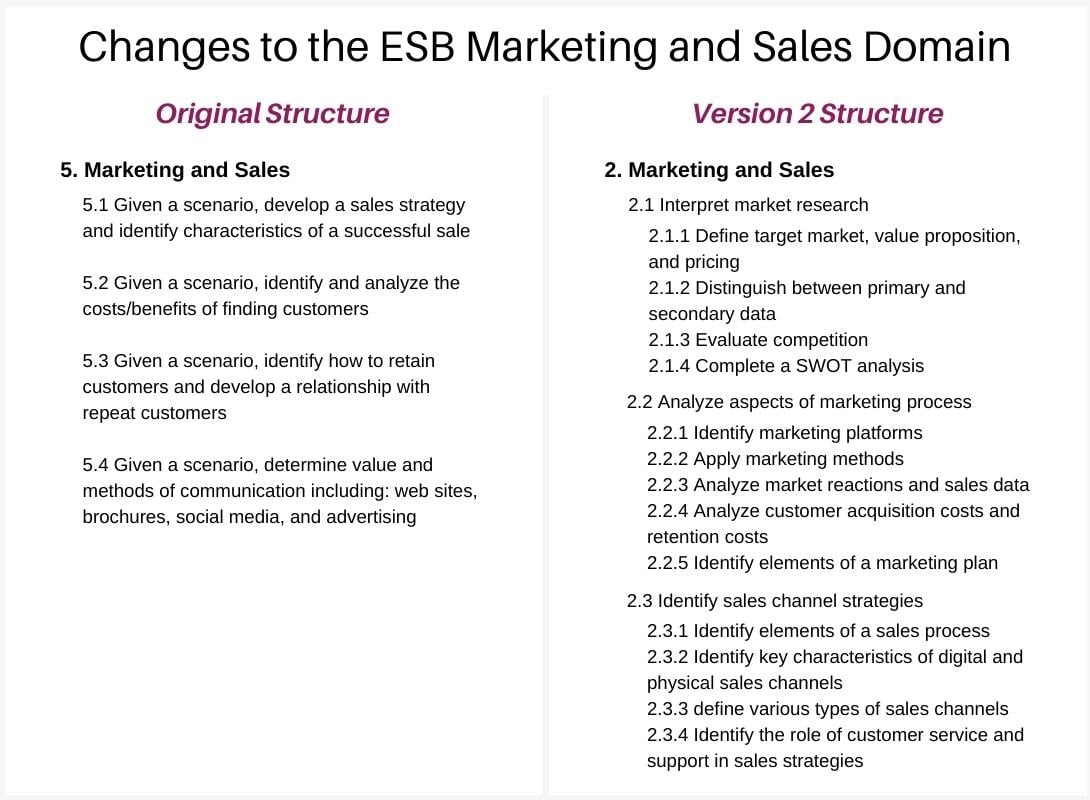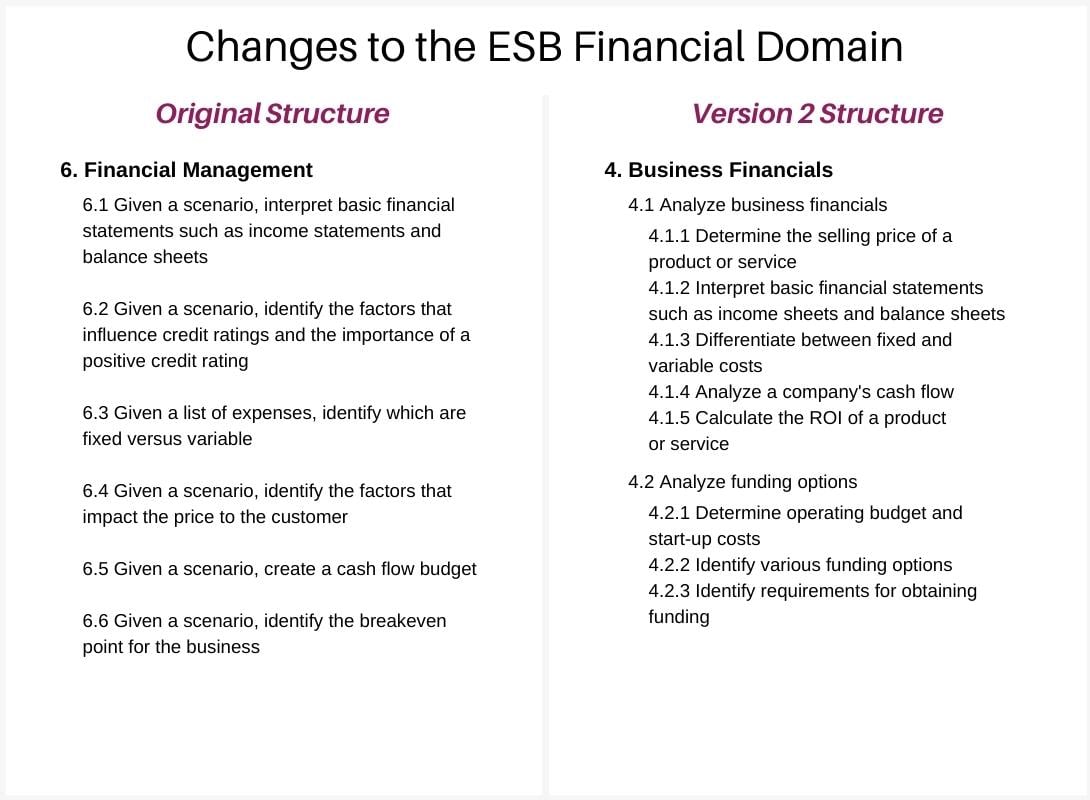Business Education | Entrepreneurship | High School
Changes to the Entrepreneurship and Small Business (ESB) Certification in 2021
Coming from a family of educators, Brad knows both the joys and challenges of teaching well. Through his own teaching background, he’s experienced both firsthand. As a writer for iCEV, Brad’s goal is to help teachers empower their students by listening to educators’ concerns and creating content that answers their most pressing questions about career and technical education.
To help students highlight their skills and abilities and prosper in their careers, many teachers prepare their students to take the Entrepreneurship and Small Business (ESB) certification.
If your students take the ESB assessment, you’ll need to know about some significant changes made to the ESB certification in 2021.
In March 2021, Certiport released a new version of the Entrepreneurship and Small Business Certification, called ESB V.2.
Version 2 of the ESB certification is designed to update and eventually replace the original ESB exam.
If you are like most teachers, you may have some questions about the new version of the ESB.
In this article, we’ll examine the differences in length, structure, and content of the Entrepreneurship and Small Business certification version 2.
After reading this post, you should understand the primary changes made to the ESB exam, so you can better prepare your students for certification success.
Structural Changes to the ESB Certification in 2021

While the aims of the Entrepreneurship and Small Business certification have remained the same, Certiport has made some notable updates to the structure of the ESB exam in ESB V.2.
Here we’ll detail each part of the ESB certification structure and explain what’s changed and what has remained the same.
ESB Certification Exam Length
The format of the new version of the Entrepreneurship and Small Business certification exam has changed slightly from the original version. For ESB V.2, students are required to answer 42 questions instead of 45. Students will still have 50 minutes to complete the test.
Changes to the Structure of the ESB Certification Objective Domains
Certiport has significantly restructured the objective domains test-takers will need to prepare for to take the ESB assessment.
For the original ESB test, students needed to study material from six domains:
- The Entrepreneur
- Opportunity Recognition
- Starting a Business
- Business Operations
- Marketing and Sales
- Financial Management
Under each domain, students taking the original version of the ESB are tested on four to seven different criteria.
The ESB V.2 condenses the subject material students need to study into four domains:
- Entrepreneurial and Small Business Concepts
- Marketing and Sales
- Production and Distribution
- Business Financials
The new structure simplifies the overall objectives for the certification by limiting the number of overarching topic areas.
In addition, the ESB V.2 introduces a new level of test subdomains between the objective domains and individual criteria. This allows Certiport to increase the clarity of specific material included in the certification test.
In the next section, we’ll look at the four objective domains of ESB V.2 and how they correspond with the original version of the exam.
Changes to the Content of the ESB Certification Objective Domains

Here, we’ll examine the four objective domains of version 2 of the Entrepreneurship and Small Business certification. We’ll see how each of the new domains compares with the standards of the original ESB assessment.
Domain 1. Entrepreneurial and Small Business Concepts

The most substantial changes to the ESB certification occur in the Entrepreneurial and Small Business Concepts domain of ESB V.2. This broad objective domain includes content from several different sections of the original ESB exam.
Domain 1 includes the following subdomains and criteria:
1.1 Identify the foundational concepts of entrepreneurship and small
business ownership
1.1.1 Define entrepreneurship and small business
1.1.2 Classify types of businesses
1.1.3 Identify various legal structures of a business
1.1.4 Identify roles and responsibilities within a business
1.1.5 Define business compensation structures
1.1.6 Define business life cycle stages
1.1.7 Identify elements of the design thinking process
1.2 Identify knowledge and skills of a successful entrepreneur
1.2.1 Identify characteristics of an entrepreneurial mindset
1.2.2 Identify the risks, benefits, opportunities, and drawbacks of being an entrepreneur
1.3 Recognize potential business opportunities
1.3.1 Identify characteristics of a business opportunity
1.3.2 Determine the viability of a business opportunity
1.4 Identify the elements of a business plan
1.4.1 Identify the purposes and value of a business plan, pitch deck, and lean canvas
1.4.2 Define the key components of a business plan and pitch deck
1.5 Identify intellectual property concepts
1.5.1 Differentiate between trademarks, trade secrets, copyrights, and patents
1.5.2 Identify the value, risks, and guidelines associated with using licensed materials
Overall, the Entrepreneurial and Small Business Concepts domain is the largest in ESB V.2 because it encompasses points from the first four domains of the original assessment.
Domain 2. Marketing and Sales

The second objective domain in version 2 of the Entrepreneurship and Small Business certification shares its name with Domain 5 in the original ESB.
However, this does not mean that the two sections are identical. Rather, the new Marketing and Sales domain was expanded to provide additional clarity in the certification standards.
Domain 2 features these subdomains and criteria:
2.1 Interpret market research
2.1.1 Define target market, value proposition, and pricing
2.1.2 Distinguish between primary and secondary data
2.1.3 Evaluate competition
2.1.4 Complete a SWOT analysis
2.2 Analyze aspects of marketing processes
2.2.1 Identify marketing platforms
2.2.2 Apply marketing methods
2.2.3 Analyze market reactions and sales data
2.2.4 Analyze customer acquisition costs and retention costs
2.2.5 Identify elements of a marketing plan
2.3 Identify sales channel strategies
2.3.1 Identify elements of a sales process
2.3.2 Identify key characteristics of digital and physical sales channels
2.3.3 Define various types of sales channels
2.3.4 Identify the role of customer service and support in sales strategies
The Marketing and Sales domain remains an integral part of the Entrepreneurship and Small Business certification. Here is a comparison between the previous and current versions of the subject area:
Domain 3. Production and Distribution

Domain 3 of the Entrepreneurship and Small Business certification version 2 concerns Production and Distribution. These are two significant aspects of day-to-day operations for a small business, which is why this section essentially replaces Domain 4 of the original ESB, Business Operations.
While some of the material from Domain 4 of the original ESB, such as intellectual property, is now addressed in Domain 1 of ESB V.2, the new Production and Distribution section places an increased emphasis on smoothly creating and delivering a product or service.
Domain 3 consists of these subdomains and criteria:
3.1 Identify the value of a Minimum Viable Product
3.1.1 Define elements of product/market fit hypothesis
3.1.2 Define performance/quality criteria
3.2 Identify supply chain and production processes
3.2.1 Identify the knowledge and materials needed to create a product or service
3.2.2 Identify production options for digital and physical products and services
3.2.3 Identify quality control testing processes for digital and physical products and services, including adherence to government regulatory and safety requirements
3.3 Identify distribution channels
3.3.1 Identify types and factors in the selection of distribution channels
3.3.2 Identify differences between direct distribution and fulfillment services
The new version of the ESB certification brings two aspects of maintaining a business, production and distribution, to the forefront more than the original exam.
Domain 4. Business Financials

The final domain of ESB V.2, Business Financials, refreshes the last part of the original ESB, Financial Management. Whereas the original ESB featured seven criteria on Financial Management, version 2 includes eight criteria divided into two main areas analyzing business financials and funding options.
Domain 4 includes the following subdomains and criteria:
4.1 Analyze business financials
4.1.1 Determine the selling price of a product or service
4.1.2 Interpret basic financial statements such as income sheets and balance sheets
4.1.3 Differentiate between fixed and variable costs
4.1.4 Analyze a company’s cash flow
4.1.5 Calculate the ROI of a product or service
4.2 Analyze funding options
4.2.1 Determine operating budget and start-up costs
4.2.2 Identify various funding options
4.2.3 Identify requirements for obtaining funding
Like the Marketing and Sales domain, the new Business Financials section reorganizes and better clarifies content from the old Financial Management domain, making it easier to teach and understand:
How Do I Best Prepare My Students for the ESB V.2?
Since some of the Entrepreneurship and Small Business certification standards have changed, you want to make sure that you are preparing your students well for the new assessment.
Certiport offers test preparation options through its GMetrix CertPREP program. These practice resources can work well when you are preparing students specifically for the ESB V.2 exam.
However, Certiport assumes that students have completed at least 150 hours of learning relevant material before sitting for the assessment. So in order to best set your students up for the ESB, you should make sure that you have enough entrepreneurship curriculum to ensure your learners are prepared.
There are a number of quality lesson plans available for teaching entrepreneurship. To help you find the right materials for your classroom, we’ve brought together some of the top entrepreneurship lesson plans for high school:




